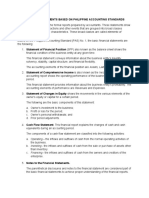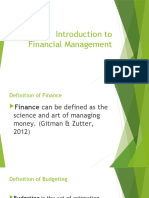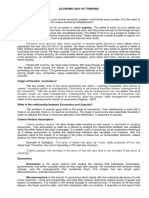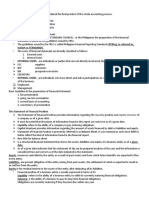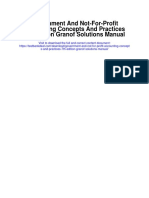The Basic Financial Statements
The Basic Financial Statements
Uploaded by
Park ChimmyCopyright:
Available Formats
The Basic Financial Statements
The Basic Financial Statements
Uploaded by
Park ChimmyOriginal Title
Copyright
Available Formats
Share this document
Did you find this document useful?
Is this content inappropriate?
Copyright:
Available Formats
The Basic Financial Statements
The Basic Financial Statements
Uploaded by
Park ChimmyCopyright:
Available Formats
THE BASIC FINANCIAL STATEMENTS
Financial Statements are the formal reports prepared by accountants. These statements show the
financial effects of transactions and other events that grouped into broad classes according to their
economic characteristics. These broad classes are called elements of financial statements.
Financial Statements are the following:
1. Statement of Financial Position – also known as the Balance Sheet shows the financial
condition of the business entity at any given time. This statement conveys information about the
business entity’s liquidity, solvency, stability, capital structure, and financial flexibility. The
accounting elements of the financial position are ASSETS, LIABILITIES, AND EQUITY.
2. Statement of Comprehensive Income – is also known as the Income Statement. This accounting
report shows the operating performance of the business entity for a given period. The
accounting elements of this report are REVENUES AND EXPENSES.
3. Statement of Changes in Equity – shows the movements in the various elements of the owner’s
equity or capital for a certain period. The following are the basic components of this statement:
a. Owner’s investments to the business.
b. Profit or loss for the period.
c. Owner’s personal withdrawals, and
d. Prior period adjustments.
4. Cash Flow Statement – The financial report explains the changes of cash and cash equivalents
during an accounting period.
A cash equivalent is a short-term, highly liquid investment that is easily convertible to cash.
The components of a cash flow statement are classified into the following activities:
a. Operating – the inflows and outflows of cash from the normal operating activities of the
business.
b. Investing – the inflow and outflow of cash from the sale or purchase of assets other than
inventory.
c. Financing – the inflows and outflows of cash from the owners and creditors of the enterprise.
The components of the cash flow statement merely explain the sources and uses of cash. CASH is
one of the components of the current assets in the Statement of Financial Position.
5. Notes to the Financial Statements – The parenthetical disclosures and notes to the financial
statements are considered part of the basic financial statements to achieve proper
understanding of the financial reports.
ELEMENTS of FINANCIAL STATEMENTS (FS)
1. Assets – These are resources owned or controlled by an entity resulting from past events and
from them, future economic benefits are expected to flow to the entity.
2. Liabilities – These are existing obligations of the entity arising from past events; their
settlements are expected to result in an outflow of assets from the entity.
3. Equity – The residual interest in the assets of the entity after deducting all its liabilities.
Note: The above elements are directly used to the measurement of financial position.
4. Revenues – These are increases in assets or decreases in liabilities arising from business
operation during an accounting period that result to increase in owners’ equity. These increases
in assets are not contributions of owners and creditors.
5. Expenses – These are decreases in assets or increases in liabilities arising from the business
operations during an accounting period that result to the decrease in owner’s equity. These
decreases in assets are not withdrawals or owners or payments of existing liabilities.
Note: The above elements are used to measure operating performance or also called as Income
Statement accounts.
You might also like
- Financial Accounting For Managers 1st Edition by Wayne Thomas, Michael Drake, Jake Thornock, David SpicelandDocument100 pagesFinancial Accounting For Managers 1st Edition by Wayne Thomas, Michael Drake, Jake Thornock, David SpicelandStudent SupportNo ratings yet
- Quick Guide Book On Operations Management With Analytics v2023Document197 pagesQuick Guide Book On Operations Management With Analytics v2023cristiancelerianNo ratings yet
- Financial Reporting and AnalysisDocument34 pagesFinancial Reporting and AnalysisNatasha AzzariennaNo ratings yet
- Chapter 3 The New Role of Human ResourcesDocument9 pagesChapter 3 The New Role of Human ResourcesLuke ThomasNo ratings yet
- Financial Statements Based On Philippine Accounting StandardsDocument3 pagesFinancial Statements Based On Philippine Accounting StandardsDashiell Robert Parr100% (1)
- Statement of Cash Flows Quiz Set ADocument5 pagesStatement of Cash Flows Quiz Set AImelda lee0% (1)
- Definition - What Are Financial Statements?Document2 pagesDefinition - What Are Financial Statements?Manuel BautistaNo ratings yet
- School of Accountancy, Management. Computing and Information Studies. Saint Louis University Maryheights CampusDocument4 pagesSchool of Accountancy, Management. Computing and Information Studies. Saint Louis University Maryheights CampusFRANCES JEANALLEN DE JESUSNo ratings yet
- FMPR2 Module BookletDocument66 pagesFMPR2 Module BookletMarjorie Onggay MacheteNo ratings yet
- E Marketing-of-Financial-ServicesDocument47 pagesE Marketing-of-Financial-ServicesAashika ShahNo ratings yet
- Financial InstrumentsDocument8 pagesFinancial InstrumentsMezbah Uddin AhmedNo ratings yet
- Perpetual Vs Periodic Inventory SystemDocument9 pagesPerpetual Vs Periodic Inventory SystemKhrystyna Kos100% (1)
- Week 1 - Module 1 PDFDocument30 pagesWeek 1 - Module 1 PDFemen penaNo ratings yet
- 3 Nature of BusinessDocument20 pages3 Nature of BusinessSeiya KapahiNo ratings yet
- Account Receivable ClassDocument30 pagesAccount Receivable ClassBeast aNo ratings yet
- Corporation-Basic ConsiderationDocument33 pagesCorporation-Basic ConsiderationIvan100% (1)
- Subsidiary LedgerDocument14 pagesSubsidiary LedgerAnnaSeptiyaniNo ratings yet
- Implications Overpriced Goods To The Customers of The Selected Sari-Sari Store Within Upper Bicutan Taguig CityDocument10 pagesImplications Overpriced Goods To The Customers of The Selected Sari-Sari Store Within Upper Bicutan Taguig CityAbedzhiaNo ratings yet
- Analyzing Business TransactionsDocument8 pagesAnalyzing Business TransactionsLyrra Jorramie Rull Grageda100% (1)
- Lesson 1: Meaning and Nature of TaxationDocument6 pagesLesson 1: Meaning and Nature of TaxationJun MagallonNo ratings yet
- UNIT III-Financial Aspects of Inventory StrategyDocument17 pagesUNIT III-Financial Aspects of Inventory StrategyMonica Lorevella NegreNo ratings yet
- Basic Accounting PrinciplesDocument3 pagesBasic Accounting PrinciplesSonu JoiyaNo ratings yet
- Ethics 2231Document2 pagesEthics 2231Alrom DonesNo ratings yet
- Introduction To Financial ManagementDocument43 pagesIntroduction To Financial ManagementHazel Jane EsclamadaNo ratings yet
- IAS 38 Intangible AssetsDocument35 pagesIAS 38 Intangible AssetsziyuNo ratings yet
- Gart Module 1 - Unit 3Document15 pagesGart Module 1 - Unit 3ataraNo ratings yet
- Chapter 1 - The First Big Question - Where Is The Organization NowDocument7 pagesChapter 1 - The First Big Question - Where Is The Organization NowSteffany Roque100% (1)
- Eight Basic Consumer RightsDocument1 pageEight Basic Consumer Rightswellalltoo13No ratings yet
- Fabm 2Document170 pagesFabm 2Asti GumacaNo ratings yet
- Perpetual Inventory Method: Accounting Practice SetDocument8 pagesPerpetual Inventory Method: Accounting Practice SetZyn Marie OccenoNo ratings yet
- Break Even Analysis PDFDocument2 pagesBreak Even Analysis PDFMohammed Raees0% (1)
- LANDBANKDocument7 pagesLANDBANKJelaina AlimansaNo ratings yet
- Loans ReceivableDocument14 pagesLoans ReceivableshaneNo ratings yet
- Chapter 01: Conceptual FrameworkDocument14 pagesChapter 01: Conceptual FrameworkCorin Ahmed CorinNo ratings yet
- Online Class House RulesDocument11 pagesOnline Class House RulesHoney Grace BuyanNo ratings yet
- Problem 4-9 Requirement 1 (Journal Entries) : Accounts Receivable 950,000 3,150,000Document5 pagesProblem 4-9 Requirement 1 (Journal Entries) : Accounts Receivable 950,000 3,150,000John SenaNo ratings yet
- Chapter 3 - Different Kinds of Obligations (1179-1182)Document2 pagesChapter 3 - Different Kinds of Obligations (1179-1182)Cheska0% (1)
- Philippine Financial SystemDocument35 pagesPhilippine Financial SystemGrace DimayugaNo ratings yet
- BSP Primer - Exchange RateDocument14 pagesBSP Primer - Exchange RateCarlo Bryan CortezNo ratings yet
- What Is Market Research?Document4 pagesWhat Is Market Research?Big LifeNo ratings yet
- Welfare and Justice For All - Economic LifeDocument10 pagesWelfare and Justice For All - Economic LifeLeeNo ratings yet
- CF FS and Reporting EntityDocument2 pagesCF FS and Reporting Entitypanda 1No ratings yet
- 1-11 Advantages and Disadvantages of FederalismDocument1 page1-11 Advantages and Disadvantages of FederalismArlyn MalabuyocNo ratings yet
- RediscountingDocument17 pagesRediscountingclandestine2684No ratings yet
- Questions and CompilationDocument15 pagesQuestions and CompilationJude Thaddeus DamianNo ratings yet
- Lecture Note in EconomicsDocument3 pagesLecture Note in EconomicsJohn Remmel RogaNo ratings yet
- Interpretation of ContractsDocument24 pagesInterpretation of ContractsRomar RuizNo ratings yet
- Efficiency RatiosDocument17 pagesEfficiency Ratiosfelize padllaNo ratings yet
- What Are The Types of Business Organization? Differentiate EachDocument3 pagesWhat Are The Types of Business Organization? Differentiate EachCarmelle BahadeNo ratings yet
- Chapter 6 Terms and DatingsDocument26 pagesChapter 6 Terms and Datingshtagle0% (1)
- Updated Module 1 2 Obligations and ContractsDocument26 pagesUpdated Module 1 2 Obligations and ContractsMaui TimbalNo ratings yet
- Article 1156-1162 NotesDocument7 pagesArticle 1156-1162 NotesHyacinth GulbenNo ratings yet
- Readings in Philippine History-Gec 102Document24 pagesReadings in Philippine History-Gec 102sophia buiserNo ratings yet
- Chapter 7Document26 pagesChapter 7Jenny Rose Castro FernandezNo ratings yet
- CHAPTER 12 Intermediate Acctng 1Document57 pagesCHAPTER 12 Intermediate Acctng 1Tessang OnongenNo ratings yet
- Who We Are - History of The Bank: Chronology of Events: Central Banking in The PhilippinesDocument3 pagesWho We Are - History of The Bank: Chronology of Events: Central Banking in The PhilippinesJuan PerezNo ratings yet
- Alternative InvestmentDocument3 pagesAlternative InvestmentdhwaniNo ratings yet
- The Fundamental Accounting EquationDocument2 pagesThe Fundamental Accounting EquationPreeny Parong ChuaNo ratings yet
- Basic Finance Chapter 1Document38 pagesBasic Finance Chapter 1jayrenNo ratings yet
- BusFin NotesDocument10 pagesBusFin NotesJeremae EtiongNo ratings yet
- Module 2Document12 pagesModule 2Ryan O. MarambaNo ratings yet
- CLOSING ENTRIES: Recall in The PreviousDocument4 pagesCLOSING ENTRIES: Recall in The PreviousPark ChimmyNo ratings yet
- Chapter 2Document2 pagesChapter 2Park ChimmyNo ratings yet
- 3 RDDocument2 pages3 RDPark ChimmyNo ratings yet
- Sample Income StatementDocument1 pageSample Income StatementPark ChimmyNo ratings yet
- Unit - 4 Final AccountDocument39 pagesUnit - 4 Final AccountHusain BohraNo ratings yet
- Company LawDocument20 pagesCompany LawGautam GoyalNo ratings yet
- The National Code of Corporate Governance For Mauritius 2016Document124 pagesThe National Code of Corporate Governance For Mauritius 2016rboodhooNo ratings yet
- GovAcctg. Modules 1 4 Part1Document58 pagesGovAcctg. Modules 1 4 Part1Sandra Doria100% (1)
- Users of Accounting Information HWDocument8 pagesUsers of Accounting Information HWAdvika SharmaNo ratings yet
- British Red Cross 2010 Trustees' Report and AccountsDocument48 pagesBritish Red Cross 2010 Trustees' Report and AccountsBritish Red Cross100% (1)
- Terminologies of Management AccountingDocument5 pagesTerminologies of Management AccountingRahat Al IslamNo ratings yet
- Pre-Model - PME2L - Business Laws - Business Correspondence - Reporting - Answer Key - (30-11-2021)Document20 pagesPre-Model - PME2L - Business Laws - Business Correspondence - Reporting - Answer Key - (30-11-2021)PradeepNo ratings yet
- Audit Report and Going Concern Assumption in The Face of Corporate Scandals in Nigeria PDFDocument7 pagesAudit Report and Going Concern Assumption in The Face of Corporate Scandals in Nigeria PDFAlexander DeckerNo ratings yet
- HSBC Bank Audit ReportDocument30 pagesHSBC Bank Audit Reporta_nevrekarNo ratings yet
- Literature Review Project FinanceDocument5 pagesLiterature Review Project Financec5qv9jtn100% (1)
- ACE PROMOTION AND MARKETING CORPORATION VS REYNALDO URSABIA and JUVY M. MANATAD VS. PHILIPPINE TELEGRAPH AND TELEPHONE CORPORATION (PT & T)Document4 pagesACE PROMOTION AND MARKETING CORPORATION VS REYNALDO URSABIA and JUVY M. MANATAD VS. PHILIPPINE TELEGRAPH AND TELEPHONE CORPORATION (PT & T)Aerwin AbesamisNo ratings yet
- Supervisory Committee Report WrittingDocument21 pagesSupervisory Committee Report WrittingkarungarikiiruNo ratings yet
- Singapore Standard On AuditingDocument14 pagesSingapore Standard On AuditingbabylovelylovelyNo ratings yet
- Audit Assertions For Loans Receivables An SCRDocument12 pagesAudit Assertions For Loans Receivables An SCRHygie AlocodNo ratings yet
- Ratio Analysis Review QuestionsDocument5 pagesRatio Analysis Review QuestionsPASTORYNo ratings yet
- M. Com. I Advanced Accountancy Paper-I AllDocument134 pagesM. Com. I Advanced Accountancy Paper-I Allatuldips100% (1)
- Government and Not For Profit Accounting Concepts and Practices 7th Edition Granof Solutions ManualDocument26 pagesGovernment and Not For Profit Accounting Concepts and Practices 7th Edition Granof Solutions ManualKathyHernandezcxgk100% (65)
- ACCTBA1 - Sample Quiz 1Document3 pagesACCTBA1 - Sample Quiz 1Marie Beth BondestoNo ratings yet
- Accounting For Islamic FinanceDocument459 pagesAccounting For Islamic Financecepi juniarNo ratings yet
- Junior Accountant - FCA - TestDocument1 pageJunior Accountant - FCA - TestShah AbdullahNo ratings yet
- FRA Questions CompleteDocument100 pagesFRA Questions CompleteSophy ThweNo ratings yet
- Kesoram CementDocument72 pagesKesoram CementPrem Raj100% (3)
- 4.2 Capital InvestmentDocument22 pages4.2 Capital InvestmentIshaNo ratings yet
- Allama Iqbal Open University, Islamabad (Department of Commerce)Document8 pagesAllama Iqbal Open University, Islamabad (Department of Commerce)Ali TahirNo ratings yet
- 9 27Document1 page9 27Melina WijayaNo ratings yet
- Analisis Laporan Keuangan Rumah Sakit Berdasarkan PDFDocument13 pagesAnalisis Laporan Keuangan Rumah Sakit Berdasarkan PDFNathaniaElizabethNo ratings yet
- R Pcpar Government AccountingDocument11 pagesR Pcpar Government Accountingdoora keys100% (1)




